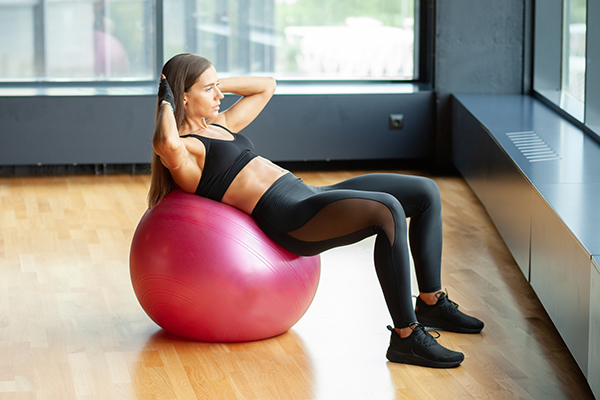The Swiss ball can be a terrific tool for developing a tight, firm midsection.
Swiss balls are an extremely popular piece of exercise equipment because of their versatility and convenience. In one poll of fitness professionals, Swiss balls were named as one of the most indispensable tools in a personal trainer’s arsenal. That’s no surprise, as Swiss balls provide total-body workouts using nothing but the ball and a set of dumbbells. And if used correctly, Swiss balls can also help you get firm abs.
Originally used in Switzerland for rehabilitation of various injuries, the Swiss ball is a large, inflatable rubber ball that places the body in an unstable training environment. In theory, the unstable nature of the modality is what produces a heightened training effect. You see, performing an exercise on the ball requires stabilization from your entire body, including your core, in order to complete the movement. This is supposed to translate into a host of benefits, including improvements in functional ability, which can translate into an enhanced capacity to perform activities of daily living, improved sports performance and a better body. But while these claims sound great in theory, they don’t necessarily pan out in practice.
Swiss Ball: a Closer Look
The main problem with training on a Swiss ball is that there’s an associated decrease in force output. During exercise performance, a portion of the force output is diverted to the stabilizer muscles, thereby diminishing the amount of weight that can be utilized in the lift. Understand that muscular development is a product of the amount of tension placed on muscles. Reduce force output and you will reduce tension, thereby impairing your ability to tone up. So, it therefore follows that using a Swiss ball rather than a more stable training surface (such as an exercise bench) will result in suboptimal results as far as body sculpting is concerned.
A study in the highly respected Journal of Strength and Conditioning Research seems to provide evidence that the Swiss ball is not as effective as traditional resistance training in upper body development.1 In the study, 10 healthy subjects were asked to perform various chest press movements on both an exercise bench and a Swiss ball. All subjects had multiple years of resistance training and experience using both stable and unstable devices. What’s more, the subjects were assigned to stable and unstable conditions in a balanced and randomized fashion in order to nullify any bias in the order of exercises. These factors are significant because it shows the study was well controlled. After a number of practice attempts, the ability to exert force was approximately 60 percent greater in the stable environment (exercise bench) than in the unstable environment (ball).
Core Training and Body Sculpting
Given the findings of the aforementioned study, you might assume the Swiss ball is all but useless as far as toning up. This, however, is not the case. Training on an unstable implement does have certain practical applications for body sculpting, especially when it comes to working the core. Before getting into the reasons why, let’s briefly review the musculature in this region.
When we speak of the core, we’re referring to abdominals and lower back. The abdominal complex is comprised of four basic muscles: the rectus abdominis, external obliques, internal obliques and transverse abdominis.
The rectus abdominis is one long sheath of muscle that runs from just underneath the breastbone (sternum) all the way down into the pelvis. When you think about the much-coveted abdominal “six-pack,” you’re referring to the rectus abdominis.
The obliques consist of two separate muscles: the external obliques and the internal obliques. These are the so-called “waist” muscles that run diagonally along the sides of your body. The external obliques are the more visible of the two muscles, spanning from the upper part of your ribs all the way down to your hips. The internal obliques lie underneath the external obliques and thus are somewhat hidden from view. For the most part, both muscles work together as a unit, helping to bend or twist your torso sideways.
The transverse abdominis lies deep within your abdomen. Although it’s not outwardly visible on the body, the transverse abdominis plays a central role in containing your internal organs as well as assisting in pulmonary function. Some fitness professionals believe it’s the hub of all body movement.
There are three primary muscles of lower back, collectively known as the erector spinae muscles: The spinalis, longisimus and iliocostalis. Covered by a thick sheath of connective tissue called the thoracolumbar fascia, these muscles attach at different points along the verterbral column to produce extension, lateral flexion and rotation of the spine. What’s more, the erector spinae function as a unit to counterbalance the pull of the abdominal muscles.
A Tight, Firm Midsection
Because of the high degree of stabilization required during Swiss ball training, muscular forces in the core region are extremely high. This was shown in a study published in the journal Physical Therapy. Eight subjects were asked to perform four different curl-up exercises: one on a stable surface and the other three on varying labile (unstable) surfaces. EMG analysis (a special test that reveals the electrical activity in a muscle) was taken at four different abdominal sites to measure the strength of the signal during each movement. The results showed that performing curl-up exercises on unstable surfaces increased abdominal muscle activity in both the rectus abdominis and external obliques significantly more than performing these movements on a stable surface. The authors went on to conclude that training the abs on stabile surfaces changes both the level of muscle activity and the way the muscles co-activate to stabilize the spine and the whole body.2 This finding implies a much higher demand on the abdominal muscles with Swiss ball training, which should lead to a harder midsection.
Another apparent advantage of using the Swiss ball in core training is that it allows a greater range of motion during performance. Since your torso is not grounded, you are able to achieve a greater degree of extension at the onset of the movement. Range of motion is an extremely important training component; the better the range, the more muscle fibers you are able to activate during the exercise – and the more fibers activated, the better your results.
Finally, the Swiss ball is a terrific apparatus for facilitating flexibility. It allows you to perform a myriad of stretches, especially for the core muscles. Stretching the back and abs, particularly at the end of a workout, ensures that you remain limber in this region. This is extremely important for promoting proper posture and the benefits of having good posture cannot be overstated when it comes to your appearance.
The bottom line is that while the Swiss ball is not a fitness panacea, it can be a terrific tool for developing a tight, firm midsection. Give some of the exercises below a try and provided you incorporate consistent, clean eating into your program, you’ll soon be sporting fab abs!
Swiss Ball Exercises
Reverse Back Extension: Place the ball under the front of your hips; place your hands on the floor in front of the ball. Extend your legs behind you with your feet hip-distance apart. Keep a slight bend to your elbows. Slowly lift your legs off the floor, keeping your knees straight, until your ankles and the back of your head are in a straight line. Hold the position for three seconds before returning to the start position.
Back Stretch: Sit on top of the ball with your feet slightly wider than shoulder-width apart and flat on the floor. Lower your head between your knees and reach your hands toward the floor. Keep your neck and shoulders relaxed. Hold two to three seconds and repeat. (For a deeper stretch, wrap your arms around the inside of your calves).
Ab Stretch: Sit on top of the ball and then walk forward until the ball is supporting your lower back. Stretch your arms out to the sides. Hold two to three seconds and then repeat.
Waist Stretch: Sit on top of the ball and then walk your feet forward until you’re lying on top of the ball. Hold two to three seconds. From this position, rotate to one side and reach your top arm over your head. Hold two to three seconds. Repeat, switching sides.
Swiss Ball Crunch: Sit on top of the ball with your feet shoulder-width apart. Walk your feet forward until your lower back is firmly supported. Keep your hands behind your head; keep your elbows wide. Lower your upper back and shoulders onto the ball. Lift your upper back and shoulders off the ball to about a 45-degree angle. Keep your hips anchored so you move over the ball and the ball does not roll under you.
Side Crunch: Lie sideways on the top of the ball. Place your fingertips by your temples; keep your elbows wide. Lower your bottom elbow toward the floor and then lift up so your trunk is parallel to your hips.
Back Extension #1: Lie with your hips on the ball and your feet wide apart behind you. Keep your knees off the floor. Place your hands palms up by your thighs. Lift your chest off the ball, rotate with palms toward the floor and squeeze your shoulder blades together. Hold the topmost position for about three seconds and then return to the start position.
Back Extension #2: Lie with your hips on the ball and your feet wide apart behind you. Keep your knees off the floor. Place your hands, palms up, by your thighs. Lift your chest off the ball. As you do, squeeze your shoulder blades together and extend your arms in front of you. Hold the topmost position for about three seconds and then return to the start position.
Crunch With Rotation: Sit on top of the ball with your feet shoulder-width apart. Walk your feet forward until your lower back is firmly supported. Place your hands behind your head; keep your elbows wide. Lower your upper back and shoulders onto the ball. Lift your upper back and shoulders off the ball to approximately a 45-degree angle. As you do, turn your torso to the left and then lower yourself. Repeat, switching sides.
Scissor Rotations: Lie on the floor with your hands extended and your palms on the floor. Place the ball between your ankles and squeeze. Lift your legs to a 45-degree angle and then rotate your legs to the right as far as possible without lifting your shoulders off the floor. Repeat on the opposite side.
Pike: Lie on the ball and walk your hands out until your ankles are on top of the ball. Keeping your legs straight, draw the ball toward your hands but do not bend your knees.
Crunch with Knee Side Curl: Lie on your hips on the ball. Walk your hands out until your insteps are on top of the ball. Pull the ball toward one shoulder and then roll it out again. Repeat, moving the ball toward the opposite shoulder.
Reverse Crunch: Lie on your back on the floor with your knees bent and legs on the ball. The ball should be wedged between your butt and calves. Lift the ball off the floor with your heels and draw your knees to your chest. Then slowly return them to the floor.
Knee Crunch: Lie on your hips on the ball. Walk your hands out until your insteps are on top of the ball. Pull the ball into your chest and then roll it out again.
References:
1. Anderson, K, et al. Maintenance of EMG activity and loss of force output with instability. J Strength Cond Res. 2004 Aug;18(3):637-40.
2. Vera-Garcia SJ, et al, Abdominal muscle response during curl-ups on both stable and labile surfaces. Phys Ther. 2000 Jun;80(6):564-9.
The post Get Firm, Sculpted Abs on a Swiss Ball first appeared on FitnessRX for Women.




